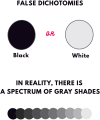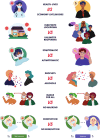COVID-19 false dichotomies and a comprehensive review of the evidence regarding public health, COVID-19 symptomatology, SARS-CoV-2 transmission, mask wearing, and reinfection
- PMID: 34315427
- PMCID: PMC8314268
- DOI: 10.1186/s12879-021-06357-4
COVID-19 false dichotomies and a comprehensive review of the evidence regarding public health, COVID-19 symptomatology, SARS-CoV-2 transmission, mask wearing, and reinfection
Abstract
Scientists across disciplines, policymakers, and journalists have voiced frustration at the unprecedented polarization and misinformation around coronavirus disease 2019 (COVID-19) pandemic. Several false dichotomies have been used to polarize debates while oversimplifying complex issues. In this comprehensive narrative review, we deconstruct six common COVID-19 false dichotomies, address the evidence on these topics, identify insights relevant to effective pandemic responses, and highlight knowledge gaps and uncertainties. The topics of this review are: 1) Health and lives vs. economy and livelihoods, 2) Indefinite lockdown vs. unlimited reopening, 3) Symptomatic vs. asymptomatic severe acute respiratory syndrome coronavirus 2 (SARS-CoV-2) infection, 4) Droplet vs. aerosol transmission of SARS-CoV-2, 5) Masks for all vs. no masking, and 6) SARS-CoV-2 reinfection vs. no reinfection. We discuss the importance of multidisciplinary integration (health, social, and physical sciences), multilayered approaches to reducing risk ("Emmentaler cheese model"), harm reduction, smart masking, relaxation of interventions, and context-sensitive policymaking for COVID-19 response plans. We also address the challenges in understanding the broad clinical presentation of COVID-19, SARS-CoV-2 transmission, and SARS-CoV-2 reinfection. These key issues of science and public health policy have been presented as false dichotomies during the pandemic. However, they are hardly binary, simple, or uniform, and therefore should not be framed as polar extremes. We urge a nuanced understanding of the science and caution against black-or-white messaging, all-or-nothing guidance, and one-size-fits-all approaches. There is a need for meaningful public health communication and science-informed policies that recognize shades of gray, uncertainties, local context, and social determinants of health.
Keywords: Aerosol; Asymptomatic; COVID-19; Coronavirus; Droplet; Harm reduction; Mask; Nonpharmaceutical intervention; Outdoor; Pandemic; Pollution; Presymptomatic; Reinfection; SARS-CoV-2; Transmission.
© 2021. The Author(s).
Conflict of interest statement
Dr. Kevin Escandón is a Senior Editorial Board Member for
Figures




References
-
- Johns Hopkins University. Coronavirus Resource Center. https://coronavirus.jhu.edu/. Accessed 1 July 2021.
-
- World Health Organization . Novel coronavirus (2019-nCoV). Situation report 13. 2020.
Publication types
MeSH terms
LinkOut - more resources
Full Text Sources
Other Literature Sources
Medical
Miscellaneous

